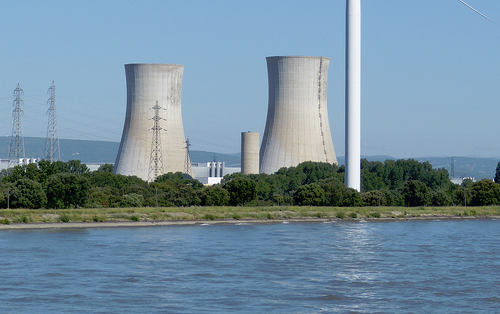Julianne Antrobus是一家名为PA咨询公司的专业服务公司的全球核电主管。他与其他许多IT行业观察家一样也认为,要解决日益增长的数据中心能源需求,至少一部分的答案在于核能。
根据美国能源部的数据,数据中心属于能源最密集的建筑类型,数据中心每层楼的能耗是典型商业办公大楼的10-50倍。美国能源部在其网站上指出,“这些数据中心空间的用电量总共占美国总用电量的2%左右,随着美国在信息技术使用方面的增长,数据中心和服务器的能源使用预计也会增长。”

Like many other IT industry observers Julianne Antrobus, global head of nuclear at professional services firm PA Consulting, believes that the answer to ever growing data center energy needs lies, at least in part, in nuclear power.
Julianne Antrobus是一家名为PA咨询公司的专业服务公司的全球核电主管。他与其他许多IT行业观察家一样也认为,要解决日益增长的数据中心能源需求,至少一部分的答案在于核能。
A nuclear-powered data center make sense from both a business and environmental perspective, Antrobus states. She notes that global data centers use more electricity than some countries. “It’s estimated that in 2020, data centers accounted for 1-2% of global energy demand.”
Antrobus表示,无论从商业还是从环境的角度来看,数据中心使用核电都是合理的选择。她指出,全球数据中心消耗的电力比有些国家整个国家消耗的电力还要多。她表示,“据估计,在2020年里,数据中心的能源需求占全球能源需求的1-2%。”
The rapid rise of data-hungry services, such as AI, will likely accelerate global data center energy consumption over the next several years. As enterprises increasingly commit themselves to reaching environmental, social, and governance (ESG) targets, such as achieving net-zero energy by 2050, they’re looking for practical ways to achieve their goals.
诸如人工智能一类的海量数据服务的迅速崛起,全球数据中心的能源消耗可能会在未来几年加速飙升。另外,业界企业也都在加大力度实现环境、社会和治理(ESG)目标(例如至2050年实现净零能耗),因而也在寻找实用的方法来实现其目标。
## **Power Sources**
电力资源
Nuclear power makes sense from an environmental perspective, since it emits almost no local or global air pollution that increases climate risk, says Akshaya Jha, a professor of economics and public policy at Carnegie Mellon University’s Heinz College.
美国卡内基梅隆大学海因茨学院的经济学和公共政策教授Akshaya Jha表示,从环境角度来看,核能是一种合理的选择,因为核能几乎不会排放增加气候风险的本地或全球空气污染物。
Still, in most cases, a data center’s power source is a local electric utility, which may or may not use nuclear power as well as fossil fuels and various renewable energy sources. “A data center consumes a certain amount of electricity,” notes Jha. “What really matters for its impact on emissions is that the power plant must increase its electricity output to satisfy demand.” Whether or not that power is green is a decision left in the hands of the utility.
然而在大多数情况下,数据中心用的电来自当地的电力公司,电力公司可能用也可能不用核能以及化石燃料及各种可再生能源。Jha指出,“一个数据中心会消耗一定量的电力。对于这个数据中心在排放方面的影响来说,真正重要的是发电厂必须增加其电力输出满足数据中心的需求。” 至于这种电力是不是绿色则是由公用事业部门来决定。
## **The Nuclear Option**
核选项
Nuclear power’s ability to supply a constant, low-carbon baseload power supply is what data centers need for continued operations, Antrobus says. “It’s also a long-term direct-power purchase that will give data center owners commercial assurance.”
Antrobus表示,核电可以提供持续的、低碳的基荷电力供应。而这正是数据中心持续运营所需要的。Antrobus称,“核电也是一种长期的直接电力采购,可以为数据中心营运者提供商业保证。”
Unlike solar and wind technologies, nuclear is one of the few forms of baseload carbon-free power available that can produce power 24/7, observes Eric Hoegger, director of power and energy at data center construction and management firm CyrusOne.
数据中心建设和管理公司CyrusOne的电力和能源总监Eric Hoegger提到,核电与太阳能和风能技术不同,核电是为数不多的可以24小时不间断发电的无碳基荷电力形式之一。
Given the fact that nuclear power is expensive and highly regulated, installing a reactor at a data center site is generally a time consuming and prohibitively expensive project. A possible solution lies in advanced Small Modular Nuclear (SMR) technology. According to the US Office of Nuclear Energy, advanced SMRs offer multiple advantages over conventional reactors, including relatively small physical footprints, location flexibility, a reduced capital investment, and provisions for incremental power add-ons.
核电比较昂贵以及受到严格管制,鉴于此,要在数据中心里安装一个反应堆通常会是一个耗时和过于昂贵的项目。一个可能的解决方案是利用先进的小型模块化核电(SMR)技术。据美国核能办公室说,先进的SMR反应堆比传统的反应堆具有更多的优势,包括占用相对较小的物理面积、部署地点的灵活性、资本投资的减少以及可提供递增的功率附加选项。
Advanced SMRs also offer strong operational and security safeguards. Nevertheless, new regulations will be needed to deploy SMRs while maintaining the same safety protocols as large-scale utility plants, Hoegger says. “Unfortunately, in the US, we don’t have a good track record of deploying nuclear power on schedule and on budget,” he says. “New small-scale modular reactors open up new possibilities, but safety -- and the regulation that goes along with that safety -- needs to be first and foremost.”
先进的SMR还可以提供强大的操作和安全保障。但Hoegger表示,部署SMR将需要新的法规,要确保其安全协议可以与大型公用事业工厂看齐。他表示,“很不幸,在按计划和预算部署核电方面我们美国过往的成绩单不太理想。新的SMR反应堆开辟了新的机遇,但安全以及与安全相关的监管需要放在首位。”
A potential challenge for SMR technology will be gaining social acceptance, particularly in terms of where the reactors can be placed. “Today, commercial nuclear reactors are almost exclusively located in remote locations away from high population densities,” Antrobus observes. “The promise for smaller nuclear plants is that their safety characteristics will enable them to be located in less remote areas, and this is where public acceptance may be a challenge.”
SMR技术的一个潜在挑战将是获得社会的认可,特别是在反应堆的放置地点方面。Antrobus表示,“商业核反应堆目前几乎全部都位于远离人口密度大的偏远地区。小型核电站可以提供的好处在于,因为其安全特性所以可以将小型核电站安置在不太偏远的地区,而这一点正是公众接受度可能成为挑战的地方。”
## **Other Choices**
其他选择
Alternative energy sources include other low-carbon technologies, but each has its own benefits and disadvantages. “Renewables, such as solar and wind, are intermittent and therefore require significant storage capacity to provide the constant baseload data centers need,” Antrobus explains.
替代能源包括其他低碳技术,但每种技术都有自己的优势和劣势。Antrobus解释表示,“诸如太阳能和风能一类可再生能源属于间歇性能源,因此需要大量的存储容量才可以提供数据中心所需的持续基荷。”
Other technologies, such as carbon capture and storage, are often viewed as an option, but present their own challenges. Most carbon capture technologies aim to block at least 90% of the carbon dioxide inside smokestacks from reaching the atmosphere. But as the capture technology approaches 100% efficiency, it gets more expensive and takes more energy to capture smokestack carbon dioxide.
其他如碳捕获和储存等技术通常也可以是一种选择,但这些技术本身也有挑战。大多数碳捕获技术的目标是阻止烟囱内至少90%的二氧化碳进入大气。而在捕获技术应用需要达到接近100%的效率时,捕获烟囱二氧化碳的成本会越来越高,也需要消耗更多的能源。
Nuclear power offers additional diversity to our power supply, Hoegger concludes. “Nuclear is really the only form of carbon-free power that’s not reliant on weather conditions.”
Hoegger在总结时表示,核电为我们的电力供应提供了额外的多样性。他表示,“核电确实是唯一不依赖气候条件的无碳电力能源。”








